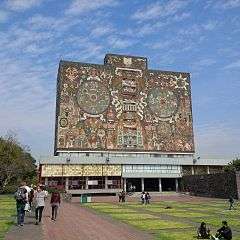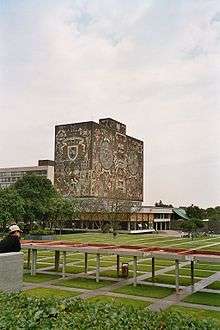Central Library (UNAM)
 Central Library exterior | |
| Established | April 6, 1956 |
|---|---|
| Location | Coyoacán, Mexico City, Mexico |
| Collection | |
| Size |
1'445,109 volumes distributed in: • 589,418 books • 323,452 magazines and journals • 2,687 brochures • 8,616 CDs • 520,936 theses |
| Other information | |
| Director | Dra. Elsa Margarita Ramírez Leyva |
| Website | http://bibliotecacentral.unam.mx/ |
The Central Library of the National Autonomous University of Mexico (UNAM), is the main library in the Ciudad Universitaria Campus. It holds one of the largest collections in Mexico, with a multidisciplinary approach for all the university courses from the adjacent faculties.
The building it's covered with the mural Historical Representation of Culture, created by the Mexican artist Juan O'Gorman.His unique masterpiece has become the most iconic building from the UNAM and from Mexican culture. In July 2007 the UNESCO proclaimed the Central Library, along with the Central Campus of the University City as World Heritage.
The Central Library hosts some of the administrative offices of the General Libraries Directorate of the UNAM.
History
In 1948 the architect and artist Juan O'Gorman, in collaboration with architects Gustavo Saavedra and Juan Martinez de Velasco designed the building with a functionalist approach, as part of the greater project of the construction of the University City on the grounds of the Pedregal de San Angel in Mexico City. Originally the building was planned to host the National Library and National Newspaper Library of Mexico. The library opened its doors for the first time on April 5, 1956.
After 25 years underwent on its first remodelation (1981-1983), with the purpose of changing from a closed to open shelfes, in order to give the users a more direct access to the collections. On 1986 extendend its service hours and begun an automatization process of the services.
Collection
In 2017 the Central Library holds 1'445,109 volumes, distributed in: 589,418 books; 323888,452 journal and magazine issues; 9 suscriptions to Mexican newspapers; 2,687 brochures and 8,616 multimedia CDs. It also has 520,936 thesis, and 299,057 of them are available for full-text access online.
Services
The Central Library offers the following services:
- Book loan (registered users only)
- Self check-out module (registered users only)
- Online loan renewal
- Information retrieval service
- Visual and motor disability equipment
- Computer room
- Photocopy
- Guided visits
The service hours are Monday to Sunday, from 8:30 to 21:30 hours, including holidays.
Architecture
The Central Library encompasses an area of 16 thousand square meters and is built on a platform three meter above the terrain, Two basalt fountains and decorative reliefs inspired bu pre-Hispanic art were placed at the base of the building. The color of the stone in these elements is in plain view, done to take advantage of the stone's texture as an aesthetic and expressive element, and to give a sense of continuity to the external pavement.
The project included ten windowless floors for book storage, each having enough space for 120 thousand volumes. These storage areas have the necessary lighting, temperature and humidty conditions for book conservation. In the reading room, flanked by a garden on each side, the diffuse and matte light is filtered through thin tecali stone slabs. The service areas of a library of such proportions were placed in the semi-basement of the building.
The façades were covered with natural colored stones that shaped the mural titled Historical Representation of the Culture. Said mural is unique because it's one of the largest int the world, taking into account its building technique based on panels that, as a whole, make up a great natural stone polychromatic mosaic. This effect was based on the combination of 12 basic colors, set in an impressionist style, that is, as colored spots that when seen from a distance become specific figures. The colors were chosen from 150 samples of original stones. The criteria for the selection was the stones resistance to weather factors such as rain, sunlight, temperature changes, etc.
Murals
The idea for the murals was proposed by O'Gorman to Carlos Lazo (Manager of the Ciudad Universitaria project). Lazo was very excited, especially by the idea of making a mural made just out of thousands of colored tiles, something that never had been done at that scale.
According to the artist, in each of the four walls that make up the surface of the mosaic he represented three fundamental historical facets of the Mexican culture: the pre-Hispanic era, the most ancient facet; the Spanish colonial era, and the modern age as a result of the two previous periods.
North Wall: Pre-Hispanic Past
This wall corresponds to the pre-Hispanic era and puts into play the life-death duality. This wall is dominated by mythical elements. On the left side of the main axis, separated into three different planes, we can see deities and scenes pertaining to the life creating principle: on the upper corner is the Sun, framed by Quetzalcoatl in the guise of a serpent; below this, the figure of Tlaloc emerges carrying a mat on his back; the section is complemented by Huitzilopochtli holding a shield and the Xiucoatl, the precious serpent. In the central section we see Tlazolteotl, the earth goddess, surrounded by the eagle, a solar attribute, and by the jaguar, the symbol of the night. Inside a temple is Teccistecatl, a masculine deity associated to the Moon and to fertility. On the lower part of this wall is a ritual ceremony of a propitiatory nature, in which the sacred meaning of the war is emphasized. The right hand side of the mural represents the antithesis of life: the world of mystery, that of the dark side of things, of evil and death. Here we can perceive Quetzalcoatl's serpent drawn by using chalchihuites (jade-like stones) and shells; below the serpent que can contemplate the image of Chalchiutlicue, the water goddess, and in front of her is a bonfire where her son is being sacrificed in order to give birth to the Moon; beside this scene we find Tezcatlipoca, the creative principle and lord of the sorcerers, accompanied by a skull. The center of this part of the wall is dominated by the dual representation of Mictlantecuhtli-Quetzalcoatl, in the lower area we find images of warriors along with prisoners of war that complement the chapter related to human sacrifice.
The vertical axis of the composition shows Tonatiuh as the primeval source of the life cycle whose permanence is guaranteed by the sacrifices of men and gods. In this part of the mural we can perceive a black and white ellipse divided in two, whose formal composition is based on the mexica cosmogonical belief that the shape of the universe is composed of two joined ellipses. This one features Tlaloc glyphs related to tonalpohualli, the most important ritual calendar of the mexica people. Said calendar was the center of their celebrations and their astronomical calculations. The finishing stroke to this side of the mural is an image of the myth concerning the founding of the city of Mexico-Tenochtitlan.
South Wall: Colonial Past
- East Wall: Contemporaneous World
- West Wall: The University and Modern Mexico
See also
- UNAM—Universidad Nacional Autonoma de Mexico
